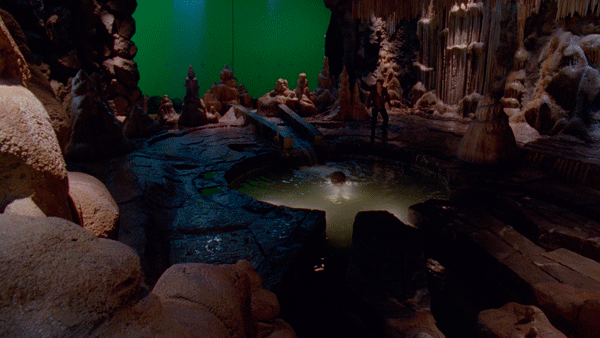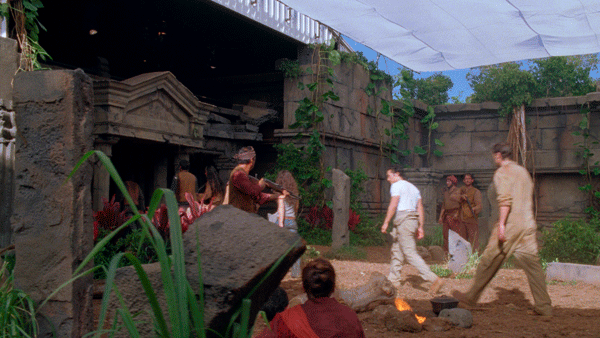Find out how Look Effects fared in completing the trippy series.
Well, Lost may be over, but while everyone is still digesting the existential outcome (the final battle between Faith and Reason), we get the first crack at revealing the VFX for the sixth and final season, including the finale. Look Effects was hired to handle vfx for the first time, and Adam Avitabile (Legion, Pushing Daisies) the visual effects supervisor, described what an extraordinary experience it was.
"It's hard for me to step back and watch it as a fan with that unknowing eye," Avitabile admits. "But, it's one of those season finales that people were either going to love or absolutely hate. I equate it with The Sopranos season finale. The show had so much momentum and so much power behind it that you could never make everybody happy. You were going to have the hardcore Lost fans, who are into every little detail and every little mystery, bummed that this one little mystery wasn't explained or that one. But I look at it from Damon & Carlton's perspective [writers Lindelof & Cuse]: it's the way they wanted to end it and they did a really good job of doing it.
For his part, Avitabile was able to push the animation further for the Smoke Monster and yet keep as much of the work in camera or as practical as possible, in keeping with the prevailing realistic tone , even with the challenge of taking on more ambitious vfx (350 shots alone for the two-and-a-half hour finale).
"I was such a fan of the series, so when I met with the producers I pitched certain ideas: for example, the Smoke Monster. It's kind of a challenging thing because it's been established for five seasons. I couldn't drastically change the look but, for me, I always wanted to put a little bit more character into Smokey through animation. We did some subtle things where, depending on the scene, he's not so much this freight train running through everything. He's looking out for that person first, finds him and then zeroes in on him. It makes a slight difference."
Look Effects is a Maya house, so animation for Smokey was done with the pre-eminent Autodesk 3D software package, rather than the LightWave 3D utilized by Eden FX in previous seasons. Look Effects also used After Effects for the flashy light and particle work (the electromagnetic energy that Desmond is subjected to for his flash sideways experience, as well as the light at the heart of the island in the finale). Compositing was done mostly in Shake with some Nuke.
For the most part, though, there was a great deal of set extension work involving matte paintings projected onto 3D objects for change of perspective. This included the temple, which was extended several levels beyond the first two, and the lighthouse on a cliff face, which was extended about six stories.
"These types of invisible effects are my favorite," Avitabile suggests. "If you've got a cloud of smoke killing people, people know it's not real. But, if you can make a building or a natural structure look natural, that, for me, is where the magic comes in because you can fool the eye.
"For the premiere this season, we did this gigantic crater in the ground that was an implosion; and when we built the set it was only a half-circle and the other back half of the wall was 60-feet of greenscreen. But if you watch the sequence, you think they've dug a big whole: it's pretty seamless."
That's not to suggest that the final season was devoid of fantastical vfx, but the flash sideways component, for instance, was done without flash. "When a character looks into a mirror, you have the reflection and the character," Avitabile offers. "That's a neat way of representing the duality, but in general, they kept those two existences fairly separate to a certain degree and within the filmmaking and the storytelling."
As for the highly anticipated finale, there were three main vfx sequences. One was a climactic fight on top of a cliff face. "Of course, it was supposed to take place in the rain -- a big, tortuous fight right on the edge of a 100-foot drop on the edge of the ocean," the vfx supervisor explains. "Of course, we filmed that in beautiful, sunny, Hawaii weather. I spent seven days on this cliff face. Everyone was harnessed in rock climbing gear to the wall. There were no horizontal surfaces to sit on. I tweaked my knee; everyone was hurt. The stunt guy broke two ribs. So a lot of it was doing color corrections they couldn't do in the DI, sky replacements where we had to, adding rain. We had two guys with fire hoses, but on a windy day on a cliff top they don't always act the way you want them to. We accentuated the practical stuff with CG rain and the island itself has a seismic shift. We pull out wide and you actually see cliff faces falling into the ocean, so full particle-type explosions raining down into the ocean and big chunks sliding off, which was really cool."
The second sequence involved a pool of light, deep within an underground cavern, which is the source of the island's power. "We built this set, which took up one of our soundstages," he continues. "We provided this pool in the middle of the room, and created this light effect. There were probably 60 shots of that alone. It starts out almost magical -- and we usually don't do magical on this show, but this is the closest we've come with twinkling particles and a pixie dust kind of thing.
"And then one of our characters goes in to pull this rock out of this pool to essentially drain it and, as a result, the pool's defense mechanism turns on and he gets buffeted by this electromagnetic energy and so it became these frenetic, chaotic light flashes that danced all over the surface of the water and him, and we had this really cool particle system coming up from the surface of the water and reacting to him. As he gets closer to the rock, it intensifies and a big blast of light shoots out. It was fun and challenging because you had to find the median point of where this effect is happening and then, when he pulls it out, it has die out in a really cool way. We probably had about five or six guys working on this stuff and they had been trained all season not to do anything flashy and over-the-top like that, so they finally let the gates loose and had fun with it. They went back and forth with color and intensity issues."
The biggest vfx sequence (175 shots) happened at the end when the remaining survivors try to escape the island by plane during the destruction, with a wide shot of some of the bluffs falling into the ocean.
"We had a plane set piece that we built and had to put the other wing and tail on it," Avitabile says. "And so they get in this cockpit and pull the thing back and we have to do all the extensions on this set piece and everything inside the cockpit was greenscreen, so I approached it like everything else this season: trying to get as much in camera as possible. Instead of doing CG environments, which would be easier for us to have control over, I shot everything practical out the window, which took some time to get it all right… We ended up doing a digital matte painting and tracking it with Maya on the actual ground plane itself to get more of a sandy texture with weeds growing in it and cracks forming to make it look a little more precarious. And then we had five full-CG shots of the plane going down the runway in various states. The plane was CG, the foliage was CG, the backgrounds were plate photography that we altered and color corrected and added the necessary elements to that we needed."
Even so, the edit wasn't locked when they started the vfx and they had a little more than three weeks to do 350 shots. "It'll probably take me a couple of months to realize the enormity of what the last year was," he concludes. "It's been an amazing experience being out in Hawaii with a crew that has been together for six years. Here I am the new kid on the block trying to do things differently. But it's to their credit that they accepted some new approaches and new ideas and the producers were happy with the results."
Bill Desowitz is senior editor of AWN & VFXWorld.











